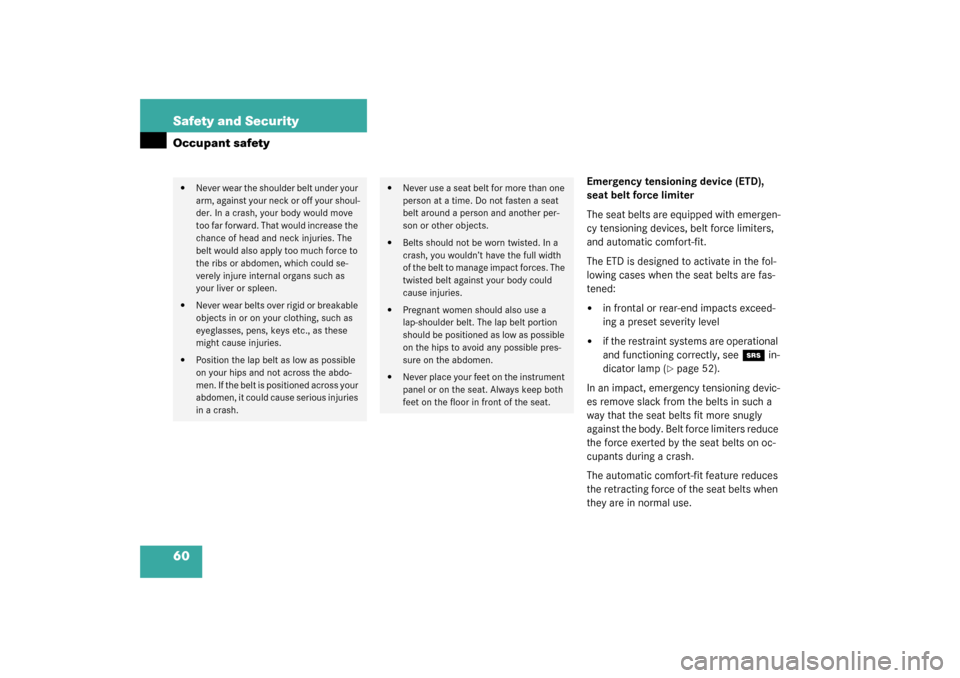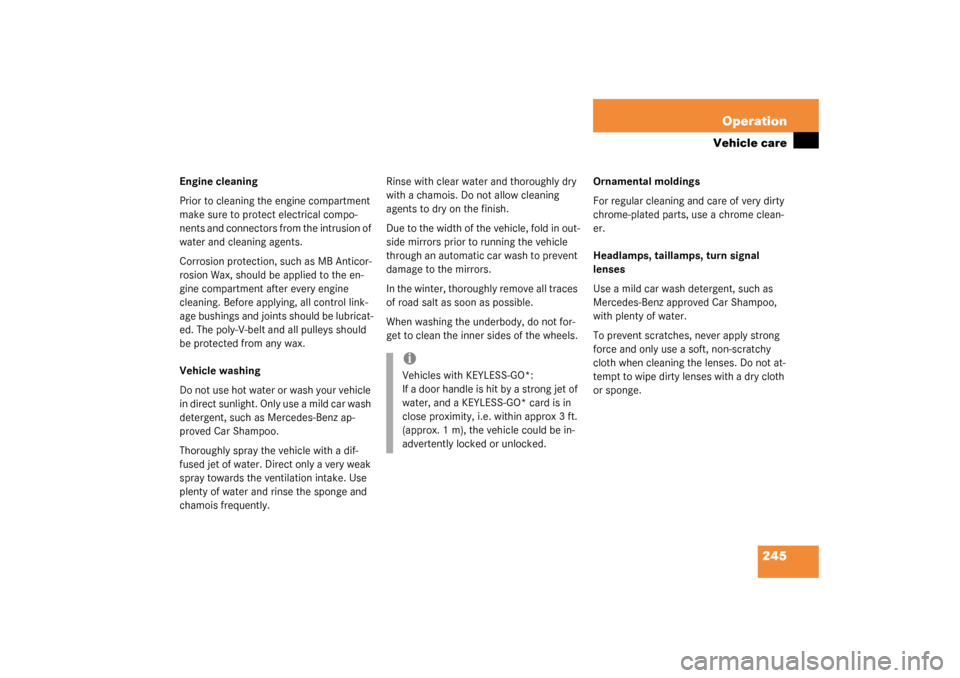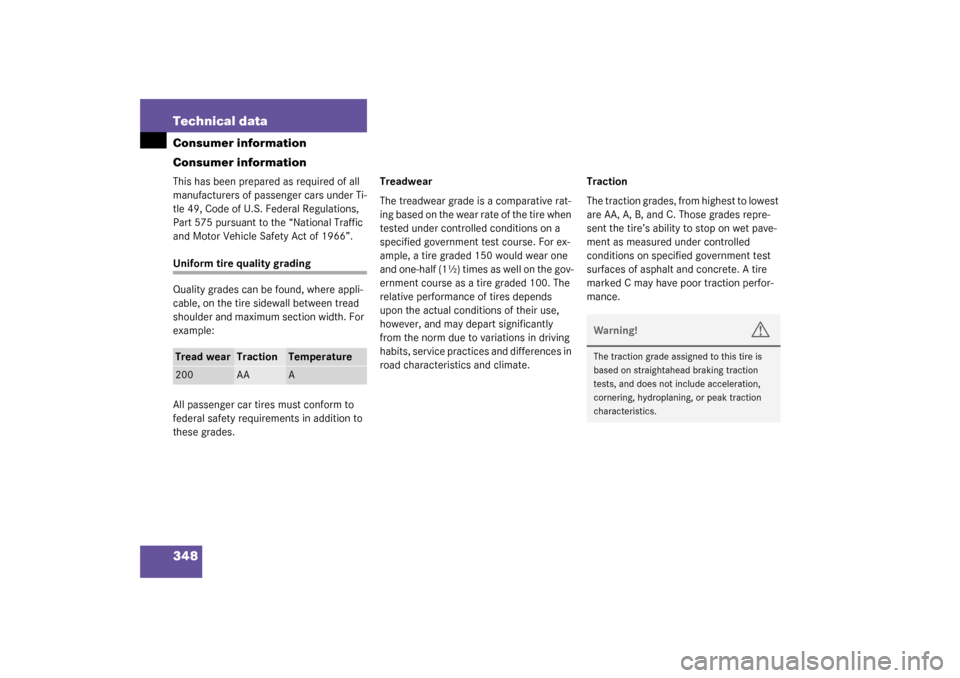Page 60 of 376

60 Safety and SecurityOccupant safety
Emergency tensioning device (ETD),
seat belt force limiter
The seat belts are equipped with emergen-
cy tensioning devices, belt force limiters,
and automatic comfort-fit.
The ETD is designed to activate in the fol-
lowing cases when the seat belts are fas-
tened: �
in frontal or rear-end impacts exceed-
ing a preset severity level
�
if the restraint systems are operational
and functioning correctly, see
1
in-
dicator lamp (
�page 52).
In an impact, emergency tensioning devic-
es remove slack from the belts in such a
way that the seat belts fit more snugly
against the body. Belt force limiters reduce
the force exerted by the seat belts on oc-
cupants during a crash.
The automatic comfort-fit feature reduces
the retracting force of the seat belts when
they are in normal use.
�
Never wear the shoulder belt under your
arm, against your neck or off your shoul-
der. In a crash, your body would move
too far forward. That would increase the
chance of head and neck injuries. The
belt would also apply too much force to
the ribs or abdomen, which could se-
verely injure internal organs such as
your liver or spleen.
�
Never wear belts over rigid or breakable
objects in or on your clothing, such as
eyeglasses, pens, keys etc., as these
might cause injuries.
�
Position the lap belt as low as possible
on your hips and not across the abdo-
men. If the belt is positioned across your
abdomen, it could cause serious injuries
in a crash.
�
Never use a seat belt for more than one
person at a time. Do not fasten a seat
belt around a person and another per-
son or other objects.
�
Belts should not be worn twisted. In a
crash, you wouldn’t have the full width
of the belt to manage impact forces. The
twisted belt against your body could
cause injuries.
�
Pregnant women should also use a
lap-shoulder belt. The lap belt portion
should be positioned as low as possible
on the hips to avoid any possible pres-
sure on the abdomen.
�
Never place your feet on the instrument
panel or on the seat. Always keep both
feet on the floor in front of the seat.
Page 245 of 376

245 Operation
Vehicle care
Engine cleaning
Prior to cleaning the engine compartment
make sure to protect electrical compo-
nents and connectors from the intrusion of
water and cleaning agents.
Corrosion protection, such as MB Anticor-
rosion Wax, should be applied to the en-
gine compartment after every engine
cleaning. Before applying, all control link-
age bushings and joints should be lubricat-
ed. The poly-V-belt and all pulleys should
be protected from any wax.
Vehicle washing
Do not use hot water or wash your vehicle
in direct sunlight. Only use a mild car wash
detergent, such as Mercedes-Benz ap-
proved Car Shampoo.
Thoroughly spray the vehicle with a dif-
fused jet of water. Direct only a very weak
spray towards the ventilation intake. Use
plenty of water and rinse the sponge and
chamois frequently.Rinse with clear water and thoroughly dry
with a chamois. Do not allow cleaning
agents to dry on the finish.
Due to the width of the vehicle, fold in out-
side mirrors prior to running the vehicle
through an automatic car wash to prevent
damage to the mirrors.
In the winter, thoroughly remove all traces
of road salt as soon as possible.
When washing the underbody, do not for-
get to clean the inner sides of the wheels.Ornamental moldings
For regular cleaning and care of very dirty
chrome-plated parts, use a chrome clean-
er.
Headlamps, taillamps, turn signal
lenses
Use a mild car wash detergent, such as
Mercedes-Benz approved Car Shampoo,
with plenty of water.
To prevent scratches, never apply strong
force and only use a soft, non-scratchy
cloth when cleaning the lenses. Do not at-
tempt to wipe dirty lenses with a dry cloth
or sponge.
iVehicles with KEYLESS-GO*:
If a door handle is hit by a strong jet of
water, and a KEYLESS-GO* card is in
close proximity, i.e. within approx 3 ft.
(approx. 1 m), the vehicle could be in-
advertently locked or unlocked.
Page 340 of 376
340 Technical dataMain dimensions
Main dimensionsModel
SL 500
SL 55 AMG
Overall vehicle length
178.4 in (4 531 mm)
178.4 in (4 531 mm)
Overall vehicle length when opening/
closing hardtop
185.4 in (4 709 mm)
185.4 in (4 709 mm)
Overall vehicle width
71.9 in (1 827 mm)
71.9 in (1 827 mm)
Overall vehicle height
51.1 in (1 295 mm)
51.1 in (1 295 mm)
Overall vehicle height when opening/
closing hardtop
65.9 in (1 674 mm)
65.9 in (1 674 mm)
Wheelbase
100.8 in (2 560 mm)
100.8 in (2 560 mm)
Track, front
61.4 in (1 559 mm)
61.8 in (1 569 mm)
Track, rear
60.9 in (1 547 mm)
61.1 in (1 551 mm)
Page 348 of 376

348 Technical dataConsumer information
Consumer informationThis has been prepared as required of all
manufacturers of passenger cars under Ti-
tle 49, Code of U.S. Federal Regulations,
Part 575 pursuant to the “National Traffic
and Motor Vehicle Safety Act of 1966”.Uniform tire quality grading
Quality grades can be found, where appli-
cable, on the tire sidewall between tread
shoulder and maximum section width. For
example:
All passenger car tires must conform to
federal safety requirements in addition to
these grades.Treadwear
The treadwear grade is a comparative rat-
ing based on the wear rate of the tire when
tested under controlled conditions on a
specified government test course. For ex-
ample, a tire graded 150 would wear one
and one-hal f ( 1½ ) ti m es as wel l on the g ov-
ernment course as a tire graded 100. The
relative performance of tires depends
upon the actual conditions of their use,
however, and may depart significantly
from the norm due to variations in driving
habits, service practices and differences in
road characteristics and climate.Traction
The traction grades, from highest to lowest
are AA, A, B, and C. Those grades repre-
sent the tire’s ability to stop on wet pave-
ment as measured under controlled
conditions on specified government test
surfaces of asphalt and concrete. A tire
marked C may have poor traction perfor-
mance.Tread wear
Traction
Temperature
200
AA
A
Warning!
G
The traction grade assigned to this tire is
based on straightahead braking traction
tests, and does not include acceleration,
cornering, hydroplaning, or peak traction
characteristics.